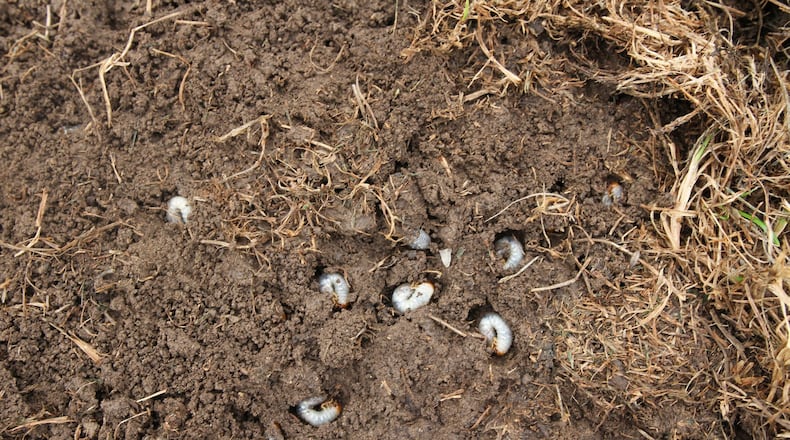This week my husband said, “I think we have grubs,” and proceeded to show me brown spots in the lawn that rolled up just like carpet. Another telltale sign — and indeed, we had grubs.
It appears that white grubs are damaging Miami Valley lawns and in some cases, they are really wreaking havoc.
Grub damage is fairly easy to spot and right now, the grubs themselves are quite visible.
Damaged turfgrass turns brown and then eventually a grayish color. The turf area itself is sort of matted or flattened.
When you tug at the dead grass, it comes up easily because the roots are completely destroyed by grub feeding.
If you have brown spots and tug at the grass and it doesn’t come up easily, it could be the result of another turfgrass insect such as bluegrass billbug.
Normally if you find grub damage in the fall, the recommendation is to wait until spring to apply grub control products.
However, this fall is somewhat different. Due to the warmer weather, grubs are at the surface and are actively feeding right now.
You can apply a pesticide and kill them at this time, however, you have to make sure that you use the right product and that you water it in.
The right product is one that contains trichlorfon or carbaryl. These two active ingredients will do the job in the fall as a curative – if they are watered in.
Trichlorfon is found in products such as Dylox or 24 Hour Grub Control. Carbaryl is found in Carbaryl or Sevin.
Read the label prior to application and don’t forget to water in! This is very important as your application is useless if you don’t.
The best option is to apply prior to a good rainfall in which we get at least one-half inch of rain.
If you don’t have time to make this fall curative application, it is a good idea to use imidacloprid, chlorantraniliprole, thiamethoxam, and clothiandin next spring in order to prevent damage next season.
The grubs I have found are not Japanese beetle grubs but chafers. These are the brown beetles you find at your porch lights in the summer.
This sort of makes sense because our Japanese beetle adult populations this summer were relatively mild in my area but the chafers were out in full force.
Remember that a fall curative application of grub control must be watered in to be effective!
About the Author
